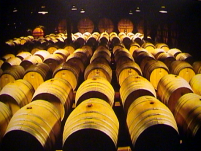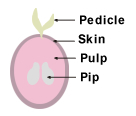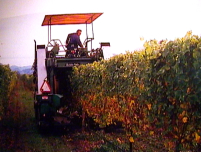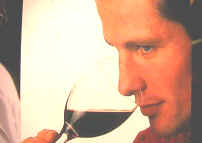
 TOP TOP
Countries Producing Wine
 Italy
(68 million hl) Italy
(68 million hl)
 France
(65 million hl) France
(65 million hl)
 Spain
(37 million hl) Spain
(37 million hl)
 California
(15 million hl) California
(15 million hl)
 Argentina
(14 million hl) Argentina
(14 million hl)
 Germany
(13 million hl) Germany
(13 million hl)
 South Africa
(10 million hl) South Africa
(10 million hl)
 Portugal
(8 million hl) Portugal
(8 million hl)
 Algeria
(huge amount not communicated /
mainly for export) Algeria
(huge amount not communicated /
mainly for export)
 Greece
(4 million hl) Greece
(4 million hl)
 Turkey
(300 thousend hl) Turkey
(300 thousend hl)
 TOP TOP
Kind
of Wine Grapes (C�page)
 Famous White Grape : Famous White Grape :
- Chardonnay, Sauvignon Blanc, Muscat, Riesling, S�millon, Chenin Blanc, Pinot Blanc,
Muscat
Turkish White Grape : Bornova Misketi (Muscat), Sultaniye (Sultanine), Emir
Famous Black Grape :
- Cabernet Sauvignon, Merlot, Pinot Noir, Syrah, Gamay, Grenache
Turkish Black Grape : Kalecikkaras�, Bo�azkere, �k�zg�z�, Papazkaras�
 TOP TOP
Alcoholic
Fermentation
 Alcoholic
Fermentation Alcoholic
Fermentation
is the transformation from juice to alcohol, by the action of Yeast, Sugar and Heat.
For White Wine: 2 to 4 weeks at 20�
For Red Wine: 1 to 3 weeks at 20�
For Ros� Wine: 1 to 3 days at 20�
 TOP TOP
Grape
Composition
 Pedicle : Contains Tanin
(necessary for conservation) and Yeast Pedicle : Contains Tanin
(necessary for conservation) and Yeast
Skin : Contains Yeast, Tanin and Oenocyanin (color)
Pulp : Contains Sugar, Acids (necessary for conservation), Protein.
Pip : Tanin and Oil
 TOP TOP
Information about Wines
 A Balanced Wine:
Balance between alcohol, sugar, acidity and tanin. A Balanced Wine:
Balance between alcohol, sugar, acidity and tanin.
Primeur Wine: Young Fruity Wine to be drunk immidiately after bottling it (within 3
months max.)
Coupage: Wine made from different grapes.
Dry Wine (Sec): Wine with very few sugar (max. 4g/l.)
Half Dry Wine (Demi Sec): A little bit sweet wine (4 to 12g/l.)
Half Sweet Wine: A sweet wine (12 to 40g/l.)
Sweet Wine: A very sweet wine (40 to 70g/l.)
Magnum: Double sized bottle (1,5 l.)
Calories: A Bottle contains 700 calories (50 per glass=apple)
Conditions to get a Good Wine : 1. Good Climate, weather conditions 2. Good Wine
Maker 3. Quality Ground 4. Good Storeroom (Cellar) 5. Quality Grape(s)
Alcohol: Wine contains 11% to 14% alcohol
 TOP TOP
White Wine
 Grape: Made from White
Grapes Grape: Made from White
Grapes
Basic Making Process: 1.Harvesting 2.Press 3. Alcoholic Fermentation (2 to 4 weeks at 20�) 4.MaloLactic
Fermentation (to reduce the acidity, 2 weeks at 18�) 5.Stabilizing (to stop fermentation
by reoxygenating) 6.Filtering 7.Bottling 8.Labelling 9.Storing
Service: 6� to 8� for a young or regular, and 10� to 12� for an old and very
famous white wine. Served in an Ice Bucket.
 TOP TOP
Red Wine
 Grape: Made from Black
Grapes Grape: Made from Black
Grapes
Basic Making Process: 1.Harvesting 2.Destalking (seperating the pedicle) 3.Alcoholic Fermentation (1 to 3 weeks at 20�) 4.Press
5.MaloLactic Fermentation (to reduce the acidity, 2 weeks at 18�) 6.Stabilizing (to stop
fermentation by reoxygenating) 7.Filtering 8.Bottling 9.Labelling 10.Storing
Service: 12� to 14� for a Primeur (young), 14� to 16� for a regular and 16� to
18� for a very famous red wine. Can be drunk during the Meal or as an Aperitif. Very
valuable old red wines must be served in a wine basket horizontally to leave the
"unwanted items" in the bottle.
 TOP TOP
Ros� Wine
 Basic Making Process can be: 1.
Black Grapes by using White Wine Vinification (Making Process), or,
2. White Grape
by using Red Wine Vinification , or 3. mixture of Red & White Wine. Basic Making Process can be: 1.
Black Grapes by using White Wine Vinification (Making Process), or,
2. White Grape
by using Red Wine Vinification , or 3. mixture of Red & White Wine.
Service: 6� to 8�. Served in Ice Bucket. Can be drunk during the Meal or as an
Aperitif.
 TOP TOP
Dessert Wine
Basic Making Process : Sweet or
very sweet wine by using White or Red Wine
Vinification.(addition of artificial sugar)
Service: 6� to 8�. Served with Ice Cubes. Can be drunk with a Dessert, with Cheese, or as an Aperitif.
Porto : Portugal
Sherry : England
Seres : Spain
Sultaniye : Kavakl�dere Turkey
 TOP TOP
Champagne
Basic
Conditions to be a Champagne:1.This Sweet wine has natural Bubbles, by the use of
an elaborated "Champenoise" method. 2. Must be Originated from Champagne
(100 km East Paris) 3. Three Grapes are only used: Chardonnay, Pinot Noir and Pinot
Meunier 4. Stored Minimum 1 year at the Winery before selling (controlled by government)
5. Production of Champagne is limited for Champagne Producers to maintain quality
(controlled by government).
Service: 6� to 8� Served in Ice Bucket. Can be drunk
as an Aperitif, during the Meal and after. Usually drunk to celebrate something.
Famous Champagnes: Moet & Chandon, Mumm, Veuve Cliquot
Taittinger
Brut Champagne contains a few amount of sugar
Extra Dry Champagne contains sugar
Dry Champagne contains more sugar
Half Dry (Demi Sec) contains a lot of sugar
Special Features: To get the best
quality, producers mixes Champage from different year of Production, reason
why there is no date of Production on the Champagne Label. Exception : Some Exceptional
Champagne are dated and called "Mill�sim�" These Champagnes are extremely
expensive (over US$500).
"A Ros� Champagne" is usually not a quality Champagne
 TOP TOP
Sparkling Wine
Basic
Making Process: All the Sweet Wines with Bubles
(usually artificial gaz, CO2) that doesn't meet all the Champagne Requirements are called
Sparkling wines. Sparking Wines are much cheaper than Champagnes, but some of them are
still very good
Service: 6� to 8� Served in Ice Bucket. Can be
drunk as an Aperitif. Also usually drunk to celebrate something.
 TOP TOP
Wine
Tasting
 Look:
Fill a glass of Wine up to 1/3 and place the glass on a white surface to see
correctly. Color is a significant indicator of the age of the wine. After shaking the wine
in circular movement, observe the draining of the wine. If the Trace are long and thick,
wine is dense and sign of quality. Look:
Fill a glass of Wine up to 1/3 and place the glass on a white surface to see
correctly. Color is a significant indicator of the age of the wine. After shaking the wine
in circular movement, observe the draining of the wine. If the Trace are long and thick,
wine is dense and sign of quality.
 Smell: .
The most dominant fruity aroma is known as prim aroma coming from the grape.
The second aroma coming from fermentation and storing are more difficult to define and are
called bouquet. Smell: .
The most dominant fruity aroma is known as prim aroma coming from the grape.
The second aroma coming from fermentation and storing are more difficult to define and are
called bouquet.
Taste: Wine is not to be drunk, it is to be chewed. If taste left you in your
palate feels sour, bitter, metallic, chemical, or cork, the wine is not quality.
 TOP TOP
Wine
Storing
Ideal
Temperature for Storing Wine : White, Rose, Champagne : 7�, Red 14�. Wine is sensitive to temperature changes, so the
temperature should be as constant as possible. A Cellar facing North is therefore
preferable.
Humidity : Wine should be stored in a high humid environment to avoid the
cork to get dry and damaged, around 70% to 80%.
Position : Wine should be stored almost horizontally, so the contact
between the cork and wine will limit air to come in. The Cellar should therefore provide a
good air circulation, avoid bad smells in the cellar.
Other Enemies of Wine : Too much lighting for a long period &
vibration.
 TOP TOP
Beers
Ingredients
: Beer is a fermented beverage made from 1. Malt 2.Yeast (TR-Maya) 3. Hops
(TR-�erbet�iotu) for bitterness 4. Water (Quality water makes quality Beer)
Basic Making Process
:1. Make Malt (soak the Barley (arpa) and heat the barley at 85� for a blond beer and 105� for a brown beer). 2. Add Water and
Hops. Cook. 3. Add Yeast, Alcoholic fermentation during 2 days. 4. Add Carbonic Gas (CO2)
5. Maturation : Store the beer during 2 months. 6. Filter. 7. Bottling & Labeling.
Alcoholic Degree: Ligh Beer 3%, Normal Beer 5%, Strong Beer 7%.
 TOP TOP
International Beers
Germany
: L�wenbrau
Belgium: Geuze
England: Bass Pale Ale
Ireland: Guiness
Holland: Heineken, Amstel
Denmark: Tuborg, Carlsberg
France: Kronenbourg
Tcheque Republic: Pilsener
USA: Budweiser
Australia: XXXX
Mexico: Corona, Sol
Turkey: Tekel, Efes |